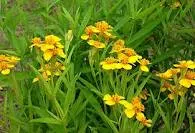MEXICAN MINT MARIGOLD, TAGETES LUCIDA
The Mexican mint marigold is native to Mexico and Central America to Guatemala . The 16thCentury Spanish explorers called it “cloud plant” and it has since acquired many other names such as sweet mace, yerba anis, Spanish tarragon, and it is substituted forFrench tarragon (Artemisia dracunculus) in cooking. It is a member of the Asteraceae or Compositae family so is related to that tarragon as well as to the common wormwood, southernwood, daisy, sunflower, pellitory or Roman chamomile,marigolds, bur marigolds, purple goat’s beard (salsify), yellow goat’s beard, theSea Aster or Sea starwort, michaelmas daisies, elecampane, the ox-eye daisy,holy thistles, costmary, tansy, feverfew, groundsel, fleabane and yarrow, just to list a few of its relatives.
It was a herb much used by the ancient Aztecs, who, so legend has it administered it to their sacrificial victims before they were killed. It was believed to have sedative an psychotropic effects.
In medicine it was used for all manner of ailments, including the common cold, colic, malaria and intermittent fevers, and a poultice of the leaves was applied to snake bites. They also used the herb for gout, swellings, digestive problems and so on.
 The plant can help to repel worms in a garden, and also slugs, but to a lesser extent; it exudes a substance from its roots that protects it from weeds such as couch-grass and this also repels bugs.
The plant can help to repel worms in a garden, and also slugs, but to a lesser extent; it exudes a substance from its roots that protects it from weeds such as couch-grass and this also repels bugs.
The dried plant was burnt as incense and also when burnt it repels insects and is considered an effective insecticide.
The plant grows to heights of around three feet by one and a half feet, and blooms in August and September. It was used as one of the flavourings in the Aztecscocoa-based drink, chocolatl, and both the petals and leaves are edible.
The Aztecs rubbed the flowers and leaves into their hands and then washed them, leaving their hands smelling sweet. The leaves are used to make a tisane which tastes like liquorice and anise mixed.
Extracts of the plant have been found to have antimicrobial, antifungal and antibacterial properties as well as antioxidant ones. The whole plant can help with digestion, and is a diuretic, and used to bring down the temperature in fevers. It depresses the Central Nervous system, and is reputed to lower blood pressure and to be a narcotic and sedative. However its narcotic and hallucinogenic effects have yet to be scientifically explained.
The Huichol people smoke it with Nicotiana rustica a wild tobacco, for the psychotropic effects it has been reported. Methyl eugenol has been extracted from the plant and this has a slightly narcotic effect. Anethole, also present in it has similar effects to adrenaline which the body produces naturally, and this can be a mild stimulant.
The tisane from the leaves or a stronger decoction is taken to relieve diarrhoea, nausea and vomiting, hiccups and fevers. It tastes very pleasant and can be sweetened with honey if required.
The plant can be made into garlands and can be harvested when still in flower and dried for later use. The flowers produce a yellow dye, and it figures prominently in the Day of the Dead celebrations, when it is place on the graves of deceased family members.
The genus name Tagetes is believed to have come from the myth of the Etruscan god, Tages who was supposed to be the grandson of Jupiter, a boy who sprang or was ploughed up from the earth, and who had the wisdom of a sage despite his youth. “Lucida” means clear and bright and either refers to the visions one has if one uses the plant for it psychotropic effects, or to the brightness of the flowers which may have reminded people of the brightness of the sun.




No comments:
Post a Comment